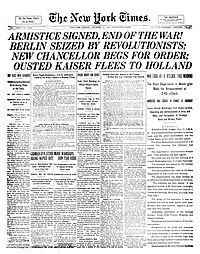In Boston in 1690, Benjamin Harris published Publick Occurrences Both Forreign and Domestick. This is considered the first newspaper in theAmerican colonies even though only one edition was published before the paper was suppressed by the government. In 1704, the governor allowedThe Boston News-Letter to be published and it became the first continuously published newspaper in the colonies. Soon after, weekly papers began publishing in New York and Philadelphia. These early newspapers followed the British format and were usually four pages long. They mostly carried news from Britain and content depended on the editor’s interests. In 1783, the Pennsylvania Evening Post became the first American daily.
In 1751, John Bushell published the Halifax Gazette, the first Canadian newspaper.
Industrial Revolution
By the early 19th century, many cities in Europe, as well as North and South America, published newspaper-type publications though not all of them developed in the same way; content was vastly shaped by regional and cultural preferences.[8] Advances in printing technology related to theIndustrial Revolution enabled newspapers to become an even more widely circulated means of communication. In 1814, The Times (London) acquired a printing press capable of making 1,100 impressions per minute.
Soon, it was adapted to print on both sides of a page at once. This innovation made newspapers cheaper and thus available to a larger part of the population. In 1830, the first penny press newspaper came to the market: Lynde M. Walter's Boston Transcript. Penny press papers cost about one sixth the price of other newspapers and appealed to a wider audience.
Impact of television and Internet
By the late 1990s the availability of news via 24-hour television channels and then the Internet posed an ongoing challenge to thebusiness model of most newspapers in developed countries. Paid circulation has declined, while advertising revenue — which makes up the bulk of most newspapers’ income — has been shifting from print to the new media, resulting in a general decline in profits. Many newspapers around the world launched online editions in an attempt to follow or stay ahead of their audience.
However, in the rest of the world, cheaper printing and distribution, increased literacy, the growing middle class and other factors have more than compensated for the emergence of electronic media and newspapers continue to grow.
Categories
While most newspapers are aimed at a broad spectrum of readers, usually geographically defined, some focus on groups of readers defined more by their interests than their location: for example, there are daily and weekly business newspapers and sports newspapers. More specialist still are some weekly newspapers, usually free and distributed within limited areas; these may serve communities as specific as certain immigrant populations, or the local gay community.
Daily
A daily newspaper is issued every day, sometimes with the exception of Sundays and some national holidays. Saturday and, where they exist, Sunday editions of daily newspapers tend to be larger, include more specialized sections and advertising inserts, and cost more. Typically, the majority of these newspapers’ staff work Monday to Friday, so the Sunday and Monday editions largely depend on content done in advance or content that is syndicated. Most daily newspapers are published in the morning. Afternoon or evening papers are aimed more at commuters and office workers.
Weekly
Weekly newspapers are common and tend to be smaller than daily papers. In some cases, there also are newspapers that are published twice or three times a week. In the United States, such newspapers are generally still classified as weeklies.
National
Most nations have at least one newspaper that circulates throughout the whole country: a national newspaper, as contrasted with a local newspaper serving a city or region. In the United Kingdom, there are numerous national newspapers, including The Independent, The Times, The



0 comments:
Post a Comment